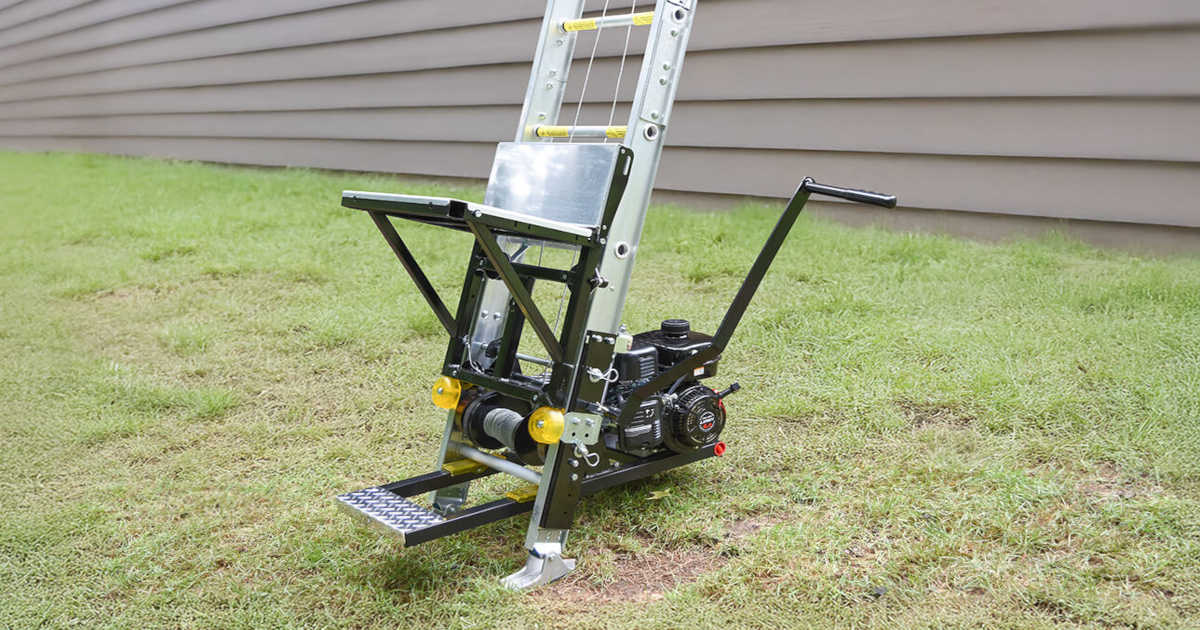Why Every Roofer Needs a Ladder Hoist: Safety, Efficiency, and Cost Savings
Posted by Steven on July 18, 2025
 Heavy equipment and supplies often need to be transported up and down ladders during rooftop construction projects. Manually carrying materials such as shingles or underlayment is not only time-consuming but also increases the risk of accidents and injury. Investing in a ladder hoist can significantly reduce that risk while saving time and improving job site efficiency. A ladder lift provides a safer, faster, and more practical alternative to carrying roofing supplies by hand. Let's explore why using a ladder hoist is a smart choice for construction professionals and contractors alike.
Heavy equipment and supplies often need to be transported up and down ladders during rooftop construction projects. Manually carrying materials such as shingles or underlayment is not only time-consuming but also increases the risk of accidents and injury. Investing in a ladder hoist can significantly reduce that risk while saving time and improving job site efficiency. A ladder lift provides a safer, faster, and more practical alternative to carrying roofing supplies by hand. Let's explore why using a ladder hoist is a smart choice for construction professionals and contractors alike.
Ladder Hoists Improve Job Site Safety
Using a ladder hoist helps establish a safer working environment. It eliminates many of the physical hazards associated with manual lifting and climbing. Below are some of the key ways a ladder hoist enhances workplace safety.
Prevent Injuries with a Ladder Hoist
As mentioned earlier, carrying materials up a ladder can easily lead to slips, trips, or falls, which often result in injury. A ladder elevator enables the secure transportation of materials, reducing the need for workers to carry heavy loads. This not only protects the worker from potential falls but also reduces strain on the body, especially the back, shoulders, and knees.
Protect Expensive Roofing Materials During Transport
Transporting roofing materials by hand increases the risk of dropping or damaging them. A ladder shingle hoist offers a more stable and secure method of lifting materials to the rooftop. By reducing the chances of materials being dropped, you also protect those working below and preserve the quality of your supplies.
Built-In Safety Features That Enhance Reliability
Most modern ladder lifts include advanced safety features for improved operation. These can include foot pedals and hand brakes for better control, carriage bumpers to minimize impact during lowering, and brake systems to prevent uncontrolled descent. Gas-powered hoists may have low-oil shutdown systems or shut-off valves for added reliability. Additionally, ladder hoists are generally designed with broader and more stable platforms than traditional ladders, enhancing overall stability during use.
Efficiency Benefits
Ladder hoists not only improve job site safety but also enhance productivity by accelerating material transport and minimizing physical strain on workers.
Boost Productivity and Reduce Strain
Ladder hoists improve safety on the job site while significantly increasing efficiency. By automating material transport, the need to carry supplies manually is eliminated, allowing crews to stay focused on critical tasks. This not only speeds up the workflow but also reduces physical fatigue, helping workers stay energized and productive throughout the day.
Versatile Across Projects
From roofing and siding to window installation and painting, ladder hoists handle a wide range of materials, shingles, drywall, insulation, paint buckets, and more. They're useful for both professional jobs and at-home projects, and even support warehouse tasks like retrieving inventory from high shelves.
Save Time and Money
Using a ladder hoist reduces labor needs, lowers injury risk, and minimizes material damage. With fewer workers required, less downtime, and fewer costly mistakes, you'll see faster project completion and improved overall cost-efficiency. It's a smart investment that pays off in safety, speed, and savings.
Gas Powered vs. Electric Ladder Hoist: Which is Best For You?
When selecting a ladder hoist, one of the key decisions is whether to choose an electric or gas-powered model. The most important factor to consider is your work environment; specifically, whether you'll be operating indoors or outdoors.
Gas-powered ladder hoists can only be used outdoors due to the exhaust fumes they produce. However, they are highly portable since they don't require a power source and are generally more affordable. They can also be used in wet conditions. The downsides include loud noise, harmful emissions, and the potential fire or explosion risk associated with combustion engines. Some job sites may even prohibit their use for safety reasons.
Electric-powered ladder hoists are quiet, clean, and emission-free, making them suitable for both indoor and outdoor use. However, they require access to grid power and should not be used in wet environments due to the risk of electric shock. They're also limited in areas where electricity is unavailable or unreliable.
Conclusion: A Smart Investment for Roofing and Construction Pros
Purchasing a ladder hoist brings numerous advantages for both contractors and construction crews. It enhances safety by reducing the risk of falls and injuries, protects materials during transport, and boosts overall efficiency on the job site. While the initial cost of a ladder hoist may seem high, the long-term savings in labor, material protection, and injury prevention make it a worthwhile investment. If you want to improve the safety, productivity, and profitability of your worksite, a ladder hoist is an essential piece of equipment you should strongly consider adding to your toolkit.